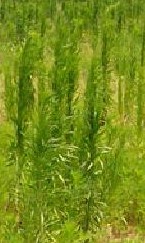
Also known has Canadian Fleabane, Coltstail, Marestail and Butterweed, horseweed is found throughout to North and Central America where it grows along road sides, and in waste areas, meadows, fields, and gardens in full sun. It is host to aster yellows disease that is carried by insects such as leafhoppers, to many garden plants including aster, zinnias, snapdragons, mums, petunias and coneflowers as well as vegetables such as lettuce carrots, tomatoes and celery.
Starting out in spring as a low rosette of broad leaves resembling Sheppard’s purse, the annual weed horseweed grows into a tall erect plant reaching up to 7’ depending on the soil fertility and moisture. Sparsely hairy unbranched stems bear long narrow leaves that are hairy, coarsely toothed and lack petioles. Leaves become progressively smaller higher up on the stem and are smooth and narrow.  During the summer and fall dense clusters of daisy-like flower heads are produced with white or lavender outer “petal’s” arranged around a central disc. Flowers are followed by an abundance of seeds equipped with short white bristles that aid in wind dispersal. A short taproot anchors the plant.
During the summer and fall dense clusters of daisy-like flower heads are produced with white or lavender outer “petal’s” arranged around a central disc. Flowers are followed by an abundance of seeds equipped with short white bristles that aid in wind dispersal. A short taproot anchors the plant.
 Control: Horseweed is easily removed from an area in spite of its taproot by manually pulling or hoeing. Herbicides containing glyphosate such as Roundup are usually effective although some resistance has developed. A pre-emergent herbicide can be used in the fall to prevent seed germination and growth.
Control: Horseweed is easily removed from an area in spite of its taproot by manually pulling or hoeing. Herbicides containing glyphosate such as Roundup are usually effective although some resistance has developed. A pre-emergent herbicide can be used in the fall to prevent seed germination and growth.